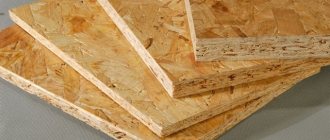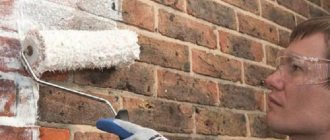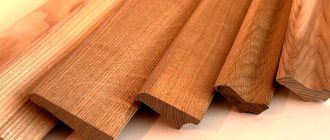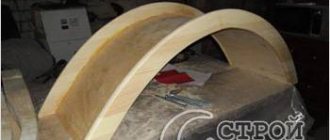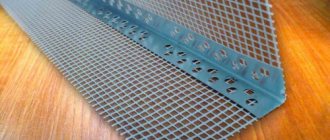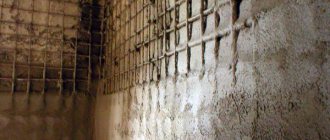Strengthening openings in brick walls.
● Various methods of strengthening openings in brick walls are designed to relieve the load from the dismantled section of the wall.
The crossbars installed over the openings must be able to support the weight of the ceilings and brickwork located above. It is not always enough to strengthen only the upper part of the opening - often you will need to build a serious frame around the entire perimeter of the opening. In any case, the construction of the opening begins with drawing its contours and marks on the partition for the installation of reinforcement elements. ● Reinforcing the opening in the load-bearing wall with the installation of a lintel made of channels. Two interconnected channels are mounted on both sides of the wall above the designed opening. Since channels are capable of withstanding significantly greater loads than corners, they are installed over fairly wide openings, on top of which there are many rows of brickwork.
● Holes for studs or bolts (from M 16 to M 24) are drilled in both channels opposite each other. The distance between them should not be more than 50 cm, and the number of studs in the jumper should not be less than three. The length of the channels must exceed the size of the opening they cover by one meter. Above the future opening, a niche is hollowed out with a height equal to the width of the profile and a depth equal to the width of the sidewalls of the profile.
● The channel is mounted in the furrow. Next, another niche is made on the other side of the wall. Holes are drilled through the fixed channel in the wall. Bolts or studs are installed in the profile and in the wall, and with the obligatory use of large diameter washers. On the other hand, concrete mortar is placed in the niche. A second channel is mounted on the mounted fastener; washers are also placed on its bolts (or studs). Both channels are tightened together using nuts, after which you can begin dismantling the brickwork for the opening.
● Several rows of bricks are dismantled under the installed channels. A steel strip with a thickness of at least 6 mm and a width equal to the distance between the jumpers is welded between the jumpers. This creates a lintel with the function of withstanding the pressure of the ceilings and walls located above it. A solid strip can be replaced with a large number of steel pieces, which will also fasten the channels together.
● A lintel with vertical posts refers to more reinforced structures - in this case, the lintels transfer part of the load to steel racks made from angles resting on the base of the opening. Such reinforcement is necessary in cases where the opening width exceeds 1.5 m. The vertical posts are welded to the lintel and secured to each other with steel strips. These strips are secured with anchors inserted into the wall through holes in the metal and brickwork.
● Openings in brick walls can be strengthened by installing racks, which are made of four channels mounted in pairs along the verticals of the opening. On each side, a pair of channels are also connected to each other using steel sheets. When marking the opening, you must remember the dimensions of the steel supports. The voids between the channels are filled with mortar.
● When installing a window opening in a brick wall, you can do without using channels.
In this case, corners with a thickness of at least 5 mm and a size of 60x60 mm are used. Corners to strengthen the opening are used for small windows - with a hole in the wall up to 60 cm and in cases where the lintels will experience only minor loads.
Recommendations and tips
The work performed to create and strengthen openings in walls made of brick or other materials is very responsible. Therefore, first of all, you need to make the correct calculations, select the appropriate materials and tools, and take into account all the features of the wall.
What you need to know about the wall before carrying out work:
- is it load-bearing or is it an ordinary partition;
- its thickness;
- whether pipes or fittings are installed in it;
- where the electrical wiring goes.
What materials to choose to reinforce openings:
- channels are suitable for brands 10P, 12P, 14P;
- the thickness of the corners must be at least 5 mm, and the dimensions of their shelves must be at least 60×60 mm;
- stud brands from M16 to M23 and the distance between them is no more than 30 cm.
To carry out the work efficiently, you will need the following tools:
- perforator;
- wall chaser;
- welding machine;
- spanners;
- devices for markings.
Before punching an opening in the wall, install an upper horizontal beam to strengthen it. The length of the steel crossbar must exceed the width of the opening by 1 m. Therefore, 0.5 m recesses are made on the sides for it.
Strengthening openings requires a responsible approach from drawing up a work project to its implementation. You shouldn’t rely only on your own strengths, especially if you don’t have enough experience. It is imperative to use the services of specialists - architects, engineers, skilled workers.
You should not save on materials and labor costs. Timely completion of work to restore the strength of a window or doorway will allow you to avoid unnecessary problems and expenses later, and ensure safety and comfortable living.
Construction and strengthening of openings in brick walls
Openings in a brick wall are made during the redevelopment of premises. Making an opening is not a difficult task, you can do it yourself, but keep in mind that the wall must be made of high-quality brick. Make sure that when delivering the material, it is provided with a technical passport with confirmed physical parameters. It is better to purchase bricks directly from the manufacturer (for example, on the website of the Nerekhta Ceramic Materials Plant or the official websites of other large enterprises).
Cutting a hole in a finished brick wall weakens its structure. To prevent the wall from collapsing, the weight that is above the opening is transferred to the crossbars - strengthening the opening. The strength of the crossbar is selected based on the force acting on the ceiling. There are three ways to strengthen the opening.
Strengthening with channels
To create such a jumper, holes are drilled in two channels for fasteners (studs or bolts from M 16 to M 24).
The holes in the profiles are located opposite each other. In this case, the lintel should not have less than three fasteners. The length of the channels should be greater than the width of the planned opening by a meter. Before dismantling the masonry, niches are cut above the opening, from the outside and inside, to deepen the channels into them.
Then the profiles are fixed in the niches with mortar. Holes are drilled in the wall through the installed profiles and studs or bolts are inserted into them. Large diameter washers are inserted under the nuts or heads. Both profiles are tightened with nuts. After this, you can begin dismantling the wall.
Knock out the brick so much that it is convenient to connect the lower surface of the lintel by welding. Channels are welded with a steel strip, the width of which is equal to the distance between the profiles and a thickness of at least 6 mm.
At this point, the channel reinforcement is ready. Such a lintel can withstand the pressure of walls and ceilings.
Jumper with vertical posts
In this type of reinforcement, the lintels transfer part of the load to the steel posts, which rest on the base of the opening.
Strengthening with this method is carried out when the opening width is more than 1.5 m. The racks are made from corners, which are welded to the lintel and to each other with steel strips. The strips themselves are secured through holes in metal and bricks with anchors. Reinforcement of openings with racks is also done in another version. The racks in this method are made of 4 channels installed in pairs along the verticals of the opening. The pairs are also tied together with steel sheets, and the voids underneath are filled with mortar. When marking under a window or door, take into account the dimensions of the steel supports.
Corner crossbar
Reinforcement of window openings is carried out without channels. Instead, they use 60x60 corners with a metal thickness of 5 mm. Such lintels are made for windows less than 60 cm wide.
To reinforce the corners, niches are not cut down; horizontal grooves are sufficient, which are made before dismantling the wall section.
Holes for fastening are drilled in the corners. One profile is immersed in the furrow, and drilling points are applied to the masonry through the holes. The lintel is removed from the wall and through holes are drilled in the masonry so that the drill enters the wall strictly perpendicular to its plane.
As the holes are ready, a groove is made on the other side of the wall for the second corner. After this, the corners are inserted with studs and washers and tightened with nuts on both sides.
Making an opening in a load-bearing brick wall is a responsible undertaking. Do not undertake anything without a project approved by the architect. Especially if your house has several floors. Due to incorrect actions, the structure of the house will be damaged.
Advantages and disadvantages of doing the work yourself
In recent years, more and more people want to carry out repairs themselves, regardless of whether they are major or cosmetic. Most repairs do not require special education; after preliminary study of the process, even a home craftsman can do them. The advantages of doing it yourself are:
- Money is saved significantly because everyone knows that the cost of performing work is almost equal to the cost of building materials;
- The quality of the final result leaves no doubt, since each owner tries to do everything at the highest level for his family;
- You gain incomparable experience in this type of work, which allows you to advise your friends and acquaintances, and in some cases, earn money.
There are also disadvantages and they must be taken into account before starting the process. They are:
- The process of remodeling walls and strengthening structures is quite labor-intensive and requires additional help, so you need to be prepared to involve relatives and friends;
- The work is quite dirty, and you also have to think about how to remove construction waste, while the construction crews clean everything up themselves;
- To facilitate operations, a special tool is needed, which is not available in every home, which means additional purchase costs will be required.
But if you really want to do all the work yourself, you can find helpers and rent tools.
Openings in brick walls
Standard openings reinforced with channel bars with SRO approval
Finished openings with corner reinforcement
according to standard projects of the authors of panel houses
Special offer - cutting the opening and strengthening it with channel bars
- STRENGTHENING OPENINGS
- DIAMOND CUTTING
- DRILLING HOLES
Openings in brick walls
| In load-bearing brick walls reinforced with a lintel made of 16 channels without waste removal. | |
| wall thickness 40 cm | 38000 |
| wall thickness 50 cm | 40000 |
| wall thickness 60 cm | 45000 |
An opening in a brick wall reinforced with a lintel made of channels.
Window in a brick wall reinforced with a lintel made of 16 channels. Additional reinforcement of facing bricks with a corner.
Opening in a brick wall with reinforced ventilation ducts according to the design
The opening is reinforced and the column is wrapped with a corner and a strip according to the design.
Opening and typical reinforcement of a brick wall
Strengthening the existing opening in the work office according to the project
Reinforced opening for the ceiling according to the design
Extension of the existing opening upwards and strengthening according to the project
Installation of racks under the ceiling
Strengthening jumpers for minor damage
If the cracks are barely noticeable, then you can limit yourself to “preventative work.” It is recommended to caulk the outside of the lintel properly. The surface is abundantly wetted with ordinary water and, when the liquid is absorbed, it is filled with a liquid cement solution. After it sets, the tow should be removed from the cracks.
If the facade is not plastered, it is recommended to fill the recesses with cement mortar and open the seams; for plastered ones, fill these “niches” in parallel with the restoration of the plaster layer.
How to make a doorway: punching an opening in a brick wall with your own hands
If you are building a house from scratch or want to remodel, you need to know how to make a doorway in accordance with all rules and standards. It should be borne in mind that there are both general standards and specific nuances in relation to individual materials.
Doorway parameters and general requirements
Arranging openings in a building is one of the design stages. A number of parameters depend on how correctly this work is performed. It is important to correctly calculate the position of doors and windows, strengthen the ceilings above them, and determine the appearance and dimensions. The area of light openings should be calculated separately. This includes not only doors, but also windows, since this concept refers to natural light from outside the building. In general, when performing calculations and installation, you should take as a basis the ratio between the area of light openings and the floor of the room in a proportion of 1:5.5 to 1:8.
The question that deserves special attention is how to make an opening for a new door in the wall of a house. In order to answer it, you also need to refer to the generally accepted standards GOST and SNiP. Today, despite the popularity of non-standard architectural and design solutions, basic parameters are still taken as a basis. Let's look at what you need to consider first:
- Height. In ordinary apartments and houses, it is customary to cut openings for doors 2 meters high.
- Width. The standard designation for the width of the door leaf is 70 and 80 cm. For living rooms it is customary to take just such doors, but for the bathroom and toilet you can reduce their width. Entrance doors can be 90 and 100 cm. It should be taken into account that additional centimeters must be left for installing the box.
- Strengthening . Since a cutout in the wall leads to a partial loss of its strength in this area, it is necessary to compensate for this factor by redistributing the load exerted from above. To do this, install a jumper or install a socket. Next we will look in detail at how to do this work yourself.
Basic parameters of the doorway
If you have high ceilings in your house and you want to create a grandiose entrance, you can deviate from the standards and install a larger structure, while coordinating these data with the overall design of the building.
Types of openings
Before cutting an opening, it is important to select the optimal types of construction. This point may not seem so significant, but in fact there can be many options. The following types of door openings can be distinguished:
- Portal. This is a standard opening made in the form of a rectangle.
- For double doors . Extended version of the portal. In this case, the height may remain unchanged, but the width of the opening increases and averages 120-150 cm.
- Arch . Basically this means a cutout with corners rounded at the top. Installing the door in the future is not at all necessary, since the curved shape creates difficulties in selecting the door, but at the same time it looks very impressive.
- Complex designs. These are non-standard solutions that may differ in unusual shape, ratio of elements, etc. They are mainly suitable for plasterboard partitions. But installation under an opening in a brick wall is best done according to the basic plan.
Types of doorways in the wall
When designing a building with your own hands, a prerequisite is to draw up a plan and mark all doorways on the drawings. In the diagram they look like an interrupted section of the wall with a line deviated to the side - this indicates the direction of plowing the canvas. This line in the drawings is connected to the wall line with an arc.
Technique used
In order to carry out high-quality work in construction, special equipment is used. The following tools are mainly used:
- Hammer. The most common method due to its availability. Despite this, it has many disadvantages: uneven cutting, increased vibration load, dust, etc.
- Drill. An alternative to a hammer drill. To drill holes yourself, you can use a core bit or a large-diameter drill. The drill is used to mark the contours of the future opening.
- Bulgarian. Allows you to work also with concrete walls and wood. To cut an opening, you need to process the wall on both sides.
- Chisel. This tool is mainly used for cleaning joints in brickwork.
- Sledgehammer. The main tool for knocking out material along cut contours.
- Diamond cutting This tool is a large model of an angle grinder. A diamond cutter allows you to cut a wall up to 40 cm thick on one side. Advanced models additionally use a construction vacuum cleaner and a container with water.
Necessary tools for punching a doorway
Brick wall
So, after checking the project on the drawings, you can get down to business directly. Since brick walls are one of the most common options for partitions in a house, you should consider the technology of creating an opening in them first.
The main feature of punching an opening in a brick wall is that the contours of the upper part must coincide with the joints in the masonry. It is not allowed to cut the brick lengthwise. After the work is completed, the jumper is installed. The same principle is observed when creating a doorway in a building made of foam blocks.
Let's consider the order of work. First, you need to check the position of the future opening on the plan with real conditions and adjust the general plan if necessary. For ease of work, boundaries are marked on the wall made of foam blocks. Since all the bricks are connected to each other, any incorrect force can lead to damage to the integrity of the entire masonry. That is why you first need to cut out the outlines of the structure.
Dust-free cutting of openings is carried out using special equipment with a diamond blade, equipped with a construction vacuum cleaner to collect dust. If you do not have a specialized tool at your disposal, you can use a grinder. After marking the contours, further work is carried out using a sledgehammer.
Very often, when doing work with your own hands, you may encounter the problem of load distribution. To minimize risks, you can first cut through only the upper part of the opening, perform strengthening work and then continue. Temporary side supports are also sometimes installed, especially when it comes to load-bearing walls made of foam blocks.
To properly distribute the load when punching an opening, jumpers are used
How to properly make a doorway in a brick or foam block wall with your own hands is now clear, but what to do when remodeling an apartment in a panel high-rise building?
Panel house
In order to make a safe opening in the wall of a panel house, you do not need to look for joints, as in a structure made of foam blocks or bricks. There are much fewer restrictions on defining contours, but the load is greater. Therefore, it is recommended to begin the installation of any doorway with the installation of a metal lintel.
Let's consider how to make an opening in a concrete wall with your own hands? The algorithm of work is the same: first, the designation is made, the contours are cut, and then the middle is taken out. If a wall made of foam blocks can be crushed with a sledgehammer, then in a panel house for reinforced concrete structures you need to additionally cut it into squares.
The installation of the doorway parts itself is carried out according to a standard scheme and is common to all types of structures. The installation of the canvas is reflected in the drawings. An exception may be an opening in a log house. This type of structure inevitably shrinks over time, so it is important to pre-cut this area.
An opening in a panel house can be created in any convenient place without being tied to the joints
How to make a jumper
The issue of organizing a jumper should be considered separately. It is a horizontal crossbar that is installed at the top of the opening and takes on most of the load.
The following materials can be used for the jumper:
- wooden beams;
- reinforced concrete beams;
- metal sleepers and profiles;
- brick with reinforcement.
Types of lintels above the doorway according to the material of manufacture
Calculation of a metal jumper
What house is complete without lintels? That's right - none! Therefore, if you are going to build a house, then this calculator may be useful to you. After all, thanks to it, you can easily calculate any metal lintel (from corners, I-beam channel, pipe, etc.), which in the future will hold structures located above door and window openings.
If you are interested in monolithic reinforced concrete lintels or lintels made directly from corners, then you need to use other calculators.
Learn more about the calculator. He is able to calculate the required moment of resistance (Wreq) and the required moment of inertia (Jreq), according to which you are already selecting a profile for the jumper.
For convenience, the calculator has 4 modes, which include the most common operating conditions for jumpers (types of loads):
Type 1 - a load-bearing wall lintel with floor slabs resting on it.
Type 2 - a load-bearing wall lintel with a floor beam resting on it.
Type 3 is a load-bearing wall lintel, on which, in addition to the wall elements, two floor beams also rest.
Type 4 - lintel of a self-supporting wall or partition.
Before you begin the calculation, carefully read the instructions to avoid mistakes.
Initial data
Span length (L) is the distance between the edges of the supports above the opening that is covered by a metal lintel.
Width of masonry (B) - this value depends on which option is yours (see figure):
Option 1 - the lintel takes the load from the entire thickness of the wall.
Option 2 - the lintel takes the load from part of the wall, for example, only from the facing brick.
Masonry material - here you select the material from which the wall is made. If it is not found or you are using a material with a different density (since materials such as foam concrete, expanded clay concrete, gas silicate are calculated with maximum densities, i.e. the heaviest), then you can select the density of materials from those proposed.
With. empty — silicate hollow.
With. full - silicate solid.
k. empty — ceramic hollow.
full — solid ceramic.
ceramic concrete - expanded clay concrete.
Masonry height (H) - you need to be especially careful here. So, there are 2 cases (see picture):
Case 1 - when the distance between the openings in height is greater than half the span, i.e. H>L/2, or there are no more openings above the opening. In this case, column “H” remains empty or the number 0 is entered there.
Case 2 - the distance between openings is less than half the span, H
Design resistance Ry - usually 210 MPa is used for calculations. But if you are sure that you will be supplied with a profile made of the steel of exactly the grade you need, then this value is set according to the scheme:
Load from floor slabs (q2) - the load that is transferred from the overlying floor slabs to the lintel (through the masonry or directly onto it).
Further we will talk only about new variables.
Floor beam load (Q) is the load that occurs at the floor beam support and is transferred to the lintel.
Distances (A and C) - distances from the edge of the supports to the place of application of loads from the beams.
Fmax is the maximum permissible deflection for lintels according to SNiP 2.01.07-85* (SP 20.13330.2011). "Loads and impacts."
Wreq and Jreb are the required moment of resistance and moment of inertia for the profile that will be used as a metal jumper. They are selected according to assortments so that the values of W and J of the profile are greater than Wrequired and Jrequired. Also, when selecting a profile, you should take into account its orientation in space.
An example of selecting a profile for a metal lintel.
An unequal corner according to GOST 8510-86 will be used as a jumper. The obtained values according to the calculation are Wreq = 0.61 cm 3. Jreq = 1.90 cm 4. And since we select the profile according to the deflection, we focus on Jreq. The nearest larger value in the X direction is for the corner L32x20x4 with Jx = 1.93 cm 4, in the Y direction - L40x30x4 with Jy = 2.01 cm 4.
Strengthening openings in brick walls
In some standard series, as well as in a number of houses built according to individual projects, or in old houses, load-bearing and non-load-bearing walls are made of brick. Solid brick walls usually have a significant thickness (several rows of masonry), while partitions are usually made half a brick thick, laying bricks on edge.
In interior non-load-bearing partitions, the opening does not have to be reinforced with rolled metal; the main thing is to immediately install a door frame or window in it, which will play the role of reinforcement and prevent the masonry from crumbling. However, in houses built before the 1950s, many interior walls are made of wood. There is no point in touching such walls without a technical opinion - some of them can support floors.
At the same time, openings in load-bearing brick walls require serious reinforcement, and in compliance with a number of mandatory conditions during its installation. The reinforcement structure here is the same as for concrete walls - it is either a U-shaped frame made of metal profiles (for doorways) or one horizontal beam (for window openings). But there are also differences, for example, the upper part of the metal structure (lintel) is always made with the plant along the edges of the opening.
It is important to take into account that openings in load-bearing walls require the development of a redevelopment project with a technical conclusion from the author of the house project. Without approval of the design documentation from the Moscow Housing Inspectorate, your opening will be considered illegal.
The main feature when installing reinforcement for a brick wall is that the reinforcement lintel must be installed before cutting the opening to prevent cracking or crumbling of the load-bearing wall. To do this, grooves are cut on each side, into which a channel is placed, which are then connected to each other with tie rods through the brick (it is better to make holes for the tie rods with a diamond drill). Only after installing the load-bearing lintel can you begin cutting the opening. To be on the safe side, it is also recommended to install temporary supports before starting work.
The method of constructing openings in a load-bearing brick wall depends on its thickness, but in any case, diamond cutting is most preferable, which provides a rather “gentle” operating mode and leaves smooth edges of the opening. As a rule, hand-held diamond saws are used for this, with which the opening is cut on both sides. In the case of very thick walls, cable cutting of bricks is sometimes used. Impact tools (jackhammer, hammer drill) for making openings in brick walls are recommended for limited use.
After cutting an opening in a brick wall, its edges are framed on each side with vertical posts made of angles or channels, which are attached to the wall with anchors and connected by through ties, and on the outside by welded plates. The side supports of the metal structure take on part of the load and provide stability.
It should be remembered that the width of the opening, reinforcement parameters and even the very possibility of creating an opening in a brick wall directly depend on the floor on which the apartment is located. The lower the floor, the greater the load the walls and ceilings take, accordingly, the more serious reinforcement will be needed, the smaller the opening will be, and often its construction may even be considered impossible.
The timing and cost of dismantling and strengthening an opening in a brick wall depend on the labor intensity of the work, i.e. depending on the thickness of the wall and the complexity of the metal reinforcement.
Reinforcement with corner profile
Strengthening the doorway in the interior brick partition is carried out using corners. Holes are first drilled in corresponding pairs of profiles. There is no need to cut out wide niches in the wall for corners. It is enough to make grooves in it, into which the profile shelves will completely fit.
First, a groove is cut from one side of the partition. A corner is inserted into it, through the holes of which marks are placed on the wall. After drilling through holes in it, a groove is made on the other side. A second corner is inserted into it. The crossbar elements are secured with fasteners. As with the installation of channels, the profiles are connected with steel jumpers.
If additional reinforcement of the doorway is necessary, its verticals are also framed with corners. They are connected by welding to the crossbar. Steel plates are welded between pairs of corners. Holes are made in them through which anchors will be inserted into the partition.
Sometimes it may be necessary to reinforce an old opening in the wall. In these cases, the window or doorway is bordered by a frame of channels or corners. She will take on part of the load.
The methods for installing the frame are practically no different from the methods described above for installing channel and angle profiles.
Opening in a brick wall - avoiding pitfalls
One of the most remodeled objects in domestic apartments is doorways: some want to expand them, others want to move them. Most often you have to redo a doorway in a brick wall, simply because brick construction is the most common.
Construction of a doorway in a brick wall
The construction of openings in brick walls must be done according to the rules. Otherwise, there is a great risk of making the doorway on the wall incorrectly and then having to redo it for a long, painful and expensive time. Therefore, when installing a new or altering an old opening, you need to take into account several nuances.
The first is building regulations, which regulate the size of the opening depending on the type of walls. In particular, the maximum arrangement of openings in load-bearing walls ranges from 70-200 cm in width with a standard height of 210 cm. No more!
It is also recommended to make the opening as close to the center of the wall as possible to ensure even distribution of the load.
Residents of the lower floors were the least fortunate, because... there, the maximum width of the opening in a load-bearing wall is only 90 cm. But don’t get upset ahead of time! The trick is that you can still make the opening wider! It is only necessary to provide for the construction of replacement support structures. Brick walls are one of the most capricious in relation to such work. Although they are believed to be durable, in reality they are not. Therefore, an impact load can damage the masonry not only where it is needed, but also around it. In this regard, experts recommend using diamond cutting on brick walls, which is much more gentle on the walls. In essence, the cutting technique is similar to the work of a diamond glass cutter; it does not affect the masonry beyond the cut hole. In addition, diamond cutting produces much less noise, dust and debris than impact cutting and requires less moisture, which means much less cleanup will be required.
Experts advise following 2 simple rules.
- Accuracy. Inaccurate markings or careless work can lead to deformation of walls and door frames.
- Precision of design. You need to decide in advance why the opening is being made. Why? Because the size of the hole in the wall itself does not necessarily correspond to the size of the object that will be installed in it. For example, to install door and window frames, the opening must exceed their size by 1 cm in width and 0.6 cm in height; for arches, a gap must be provided for finishing, etc.
Punching a doorway in a brick wall
Despite progress, impact is still the leading method of constructing doorways. This can be explained both by its low cost and by the fact that it does not require special qualifications from the performer.
The work can be divided into several stages:
- Marking the future opening. In the absence of special instruments, it is better to do this with a large square and a meter ruler. In this case, it is advisable to make the markings on the outside of the wall, and remove all existing coatings (plaster, whitewash, wallpaper, etc.) at the marking site so that the masonry is visible. This is necessary in order to correctly install the support jumpers at the required height. Having noted the position of the jumpers, you need to make more marks for the supports at a distance of 15 cm from them.
- Installation of supports. They are installed only when the opening width is more than 90 cm, because... The brickwork will withstand a shorter distance on its own. The distance from the supports to the walls is 60-90 cm. The supports are either brick pillars (but this takes a long time, since you need to wait for the mortar to set and is expensive) or reinforced concrete beams.
- We make holes for supports and studs. Through holes are drilled at the previously marked points; then you will have to work with a hammer and chisel to make the holes rectangular. The studs themselves have a size of approximately 75*100 mm and are made from beams. The finished pins are inserted into the holes and supported by vertical supports. After adjusting the structure vertically, you can secure everything with nails. The result will be the outline of the future opening, separated from the rest of the masonry by supports. This is necessary so as not to damage the entire wall when knocking it out.
- All covering materials (plaster, paint, etc.) are removed from the wall inside the contour - using the same hammer and chisel. Outside the contour too, about 2-3 cm. We begin to disassemble the wall from the lintel, that is, from top to bottom. A hammer drill can help here. Having made the hole level, you can insert a support beam that will hold the arch. All holes are filled with mortar, and work is stopped until it completely hardens.
When you need to strengthen
If a new house is being built, then when drawing up the project, the most suitable method of strengthening door and window openings and arches is taken into account. But there are situations when it is necessary to strengthen the opening in an existing building.
Cases when it is necessary to strengthen openings:
- If the walls of the building have become deformed, cracked due to time or mechanical damage. The technical condition of the house needs to be monitored. If cracks appear, the cement bonding layer is destroyed, or bricks fall out, restoration work must be urgently carried out. Timely measures taken will help keep the premises in good condition longer.
- When redevelopment is carried out, the holes are widened or they are made in other places. In these cases, reinforcements are installed even before new openings are dismantled. First, you need to draw up a project for carrying out the work, after consulting with a specialist, whether it is possible to break through the wall in the chosen place, and whether this will weaken the structure of the building.
- When replacing windows, you need to check before carrying out the work how strong the opening is, and, if necessary, pre-strengthen it before dismantling the old window.
Do I need permission?
Reconstruction and strengthening of a finished window or door unit is not reconstruction and therefore does not require special permission. But during redevelopment, when you have to punch a new hole in the wall, you must fill out the appropriate documents. Without them, such work will be considered unauthorized and may entail not only administrative problems, but also lead the building into disrepair.
First of all, you need to conduct a survey of the premises, inviting specialists to do this. If the house is already old and multi-storey, then due to its dilapidation it is unlikely to be able to obtain such permission. Another situation is when the neighbors above or below have already done redevelopment. Then the new door can only be made on the same level as the one in their apartment. Because placing openings in one wall at different levels can greatly weaken its load-bearing capacity.
OPENING IN A BRICK WALL
When remodeling and large renovation work, the idea often comes to make additional doors, an additional window, or expand the existing opening. In most cases, however, there is a brick wall standing in the way of your desire that needs to be cut through.
Careful planning of cutting openings in brick walls protects against possible indirect and expensive damages. Therefore, before starting work, you should definitely consult with specialists and find a house or apartment plan.
SERVICES
CUTTING BRICK WALLS
STRENGTHENING BRICK OPENINGS
You can order services for arranging openings in brick walls by calling: 8-903-728-02-87; 8-495-728-02-87.
You can also use the order form from the website.
We have the necessary SRO approvals and licenses for the services provided
We have trained personnel: engineers, diamond cutting operators, welders
In our work we use European equipment Hilti , Bosh , DeWalt , Makita , Tyrolit Hydrostress , Weka
PRICES FOR OPENINGS IN BRICK WALLS
- Removing garbage and loading 1 container of 8 m3 and weighing 5 tons with an elevator - 4,000 rubles. Ordering a container 8m3 and weighing 5t – 4,500 rubles.
- The minimum cost of work is 8,000 rubles.
The noise level during cutting has acceptable standards determined by Moscow Government Decree N 73-PP “On the procedure for reconstruction and (or) redevelopment of residential and non-residential premises in residential buildings on the territory of the city of Moscow.”
DESIGNING AN OPENING IN A BRICK WALL
Making an opening in a brick wall is not an easy task, and in most cases it represents an intervention in the load-bearing capacity of the house with the obligatory strengthening of the wall . Reinforcement of brick openings should be made in the form of a U-shaped frame made of a channel and an angle and includes a beam (lintel) and two racks resting on a steel sheet to evenly distribute the load.
Making an opening in a brick can be divided into three parts:
- Installation of a beam in brick above the future opening
- Punching an opening in a brick wall
- Reinforcing the opening along the contour
A gross violation of the work technology and deviation from design decisions can create a dangerous situation: an opening in a brick wall made by unqualified “specialists” can lead to dire consequences.
BEAM IN BRICK
The beam above the opening takes on the weight of the brickwork and the overlying floors. In other words, the purpose of the beam is to carry and redistribute the load that was previously carried by the cut out fragment of the wall. The beam is made from a steel angle or channel.
Types of products
The lintels used for arranging brick walls are different:
- reinforced concrete,
- metal (made from channel and corners),
- brick,
- wooden,
- cellular prefabricated,
- reinforced brick.
Reinforced concrete
Reinforced concrete products are prefabricated and monolithic. Prefabricated ones include the following types:
- bar (PB) of square or rectangular cross-section (maximum width – 250 mm, length – 1031-5960 mm);
- slab (PP), two options in width (1 – 381 mm, 2 – 511 mm), height (141-221 mm) and length (maximum – 2981 mm);
- beam (PG), with a stepped section (a protruding flange for supporting the floor slab), width 250, 380, 510 mm, length - 1550-5950 mm.
There is also a facade type of lintel, but experts often classify it as PG, but with a slight difference - at the ends the shelf is made with recesses, and is clearly visible from the facade.
PP and PB are considered interchangeable. They have identical height and length, but differ only in width. This option is used if there are no slab-type lintels available at the construction site.
Monolithic lintels are installed in the wall itself using formwork. At the same time, they calculate the height of the structure (1/10-1/12 of the opening dimensions), with mandatory reinforcement (metal rods with a diameter of up to 12 mm).
Metal
For such jumpers, rolled steel is used. They can make floors of 2-5 m, and they can be laid in both load-bearing and non-load-bearing parts. For brick walls, along with reinforced concrete products, this is one of the ideal options.
This product will withstand very heavy loads, as it is durable. Since such jumpers can be of any length, there are no questions when arranging openings of non-standard width.
Steel corners have a number range; numbers 10-12 are especially recommended for the construction of wall structures.
Brick
They can be arranged in a straight line or curved (arch). The rectangular version is laid on the formwork, according to the rules for laying and tying bricks. Here you can create a wedge shape along the vertical seams of the masonry.
It is necessary to ensure that the seams are inclined and there is no vertical movement of the bricks. The work must take into account the width of the opening.
The lifting booms are located in the range of 1/6 - 1/10 of the opening width. Curvilinear arches are laid out on a specially made circle - an arched device made of metal or plywood.
In practice, a metal circle for arches is more preferable, since its shape is easy to align or bend.
Wooden
This type of lintel is made from good quality boards, special plates and logs with edging and timber.
The ends of such structures are embedded into the wall, no less than 25 cm. Wooden lintels are easy to build with your own hands. They can last for many years (more than 50 years), but must be insulated from moisture penetration.
Therefore, when installing them, the products must be wrapped in insulating material (made of polypropylene, rubber, roofing felt, polyethylene). In modern construction, such floors are used less and less, despite their most affordable cost, since products made of reinforced concrete and metal are more durable.
Cellular prefabricated
Such products are made from cellular concrete, which can be reinforced and arched. The height of such a lintel is 125 mm, and the depth of its support is 200-250 mm. This type of lintel for brick walls is not yet very common.
Many experts believe that this material is more suitable for a wall built from the same cellular concrete.
Reinforced brick
They are made of brick and reinforcing metal components - hence their name. They are created according to the same principle as brick ones - straight or arched.
There is another way of laying this type - in the form of a collapse vault. Only a professional can perform this method.
Each of the listed types of jumpers is good in its own way. Which one is suitable in each specific case depends on the time of construction (renovation of an old building, new building), additional materials used, in addition to bricks, the existing plan and structure diagram (drawing), the wishes of the customer and the material component.
The nuances of expanding windows
Depending on the design idea, the expansion can be vertical or horizontal. Both options require a professional approach and consultation with design organizations. Do not carry out repair work yourself unless you have the appropriate qualifications.
Vertical expansion - combining rooms or a room with a balcony. The window opening is enlarged due to the complete demolition of the wall or part of the wall with a window sill. In this case, the heating battery is installed in a new location and there are certain rules:
-You cannot move the radiator to a balcony or loggia. The only option is to place the battery on the opposite wall, inside the room.
-After the redevelopment, the balcony area of the apartment will still be considered non-residential and will be listed as non-residential premises in all documents.
Please note that in most multi-storey buildings, the wall between the room and the balcony holds the balcony slab and its demolition can cause extensive damage to the building, and casualties are not excluded.
Avoid the collapse of walls and ceilings! Experts insist: you can remove the window and door frames, but you don’t need to touch the partition itself. From the window sill you can organize either a table or a bar counter.
Horizontal expansion of a window opening is an increase in the window structure only in width. Whether it is possible to increase the window opening in an apartment in a similar way should be decided by specialists, since reinforcing elements for the facade may be needed. Entrust the calculation of parameters to trusted builders to avoid any cracks, chips and collapses.
The process of strengthening openings
Reinforcing an opening in load-bearing brick walls is carried out in several stages and requires extreme care and attention. All work can be divided into the following points:
Technique for strengthening the opening
- Choosing a location for a metal structure. If new windows or doors are needed during the redevelopment process, then grooves are first made, into which channels or corners are then attached. After this, the metal structure is tightened using pins;
- Next, the brickwork is dismantled. This operation must be performed quite carefully, pulling out the bricks piece by piece;
- After carefully inspecting the metal frame to ensure it adheres to the brick, decorative finishing can be done.
If it is necessary to strengthen existing window or door elements that have fallen into disrepair due to a long service life or exposure to external factors, then the instructions for implementation will look like this:
- A U-shaped frame is assembled from a channel that corresponds to the width of the wall;
- Then the metal structure is placed in the opening and fixed with anchors;
- If the channels do not fit tightly, then it is permissible to use metal plates for alignment;
- After tightly fastening the frame, you can begin finishing work.
If you choose to strengthen openings in brick walls using channels, then the edges of the brickwork must be sanded; this is easiest to do with diamond tools.
The best option for strengthening brickwork is a corner. When using it, you can achieve the tightest possible fit to the wall and, importantly, access to the interior of the structure remains free, which facilitates further finishing. Work on strengthening corners looks like this:
Strengthening walls and openings
- In the finished opening, grooves of suitable size are cut out using a wall chaser;
- Install vertical posts, which will then take on a large load and connect them with corners. The mounting option is not important; it can be done either level or overlapping;
- Some of the corners that run at the top of the opening are tightened with pins;
- After this, the entire structure is pulled together into one whole.
If all the strengthening work is done correctly, then after the decorative finishing the metal parts are completely invisible.
The nuances of expanding windows
Depending on the design idea, the expansion can be vertical or horizontal. Both options require a professional approach and consultation with design organizations. Do not carry out repair work yourself unless you have the appropriate qualifications.
Vertical expansion - combining rooms or a room with a balcony. The window opening is enlarged due to the complete demolition of the wall or part of the wall with a window sill. In this case, the heating battery is installed in a new location and there are certain rules:
- You cannot move the radiator to a balcony or loggia. The only option is to place the battery on the opposite wall, inside the room.
- After redevelopment, the balcony area of the apartment will still be considered non-residential and will be listed as non-residential premises in all documents.
Please note that in most multi-storey buildings, the wall between the room and the balcony holds the balcony slab and its demolition can cause extensive damage to the building, and casualties are not excluded.
Avoid the collapse of walls and ceilings! Experts insist: you can remove the window and door frames, but you don’t need to touch the partition itself. From the window sill you can organize either a table or a bar counter.
Horizontal expansion of a window opening is an increase in the window structure only in width. Whether it is possible to increase the window opening in an apartment in a similar way should be decided by specialists, since reinforcing elements for the facade may be needed. Entrust the calculation of parameters to trusted builders to avoid any cracks, chips and collapses.
In which buildings can windows be expanded?
In addition to concern for the stability, strength and appearance of the building, approval of changes in the layout of the living space is conditioned by the safety of the following elements:
- communications;
- frame;
- engineering networks.
The easiest way to agree on window extensions is for brick council houses. Not only representatives of the State Housing Inspectorate, but also employees of enterprises involved in repair projects have a negative attitude towards redevelopment in panel houses. Most of the walls in many panel buildings are load-bearing, which is why they refuse to convert internal partitions.
One of the important criteria for approval of repairs is the harmony of the changes made with the facade of the building.
Increasing the window area will not affect the stability of, for example, a modern monolithic high-rise building with a load-bearing frame. However, the hopes of those wishing to find out whether it is possible to increase the window area will be overshadowed by the fact that the current high-rise buildings of a monolithic type are designed with an attractive design, which will be affected by the renovation.
In private buildings, windows can be expanded without obtaining official permission, but for safety reasons it is recommended to submit a work plan for assessment by a specialist.
How to enlarge a window opening in a private house
You can increase the window opening both in length and width.
You can also combine two adjacent windows by eliminating the partition between them. This will allow you to install one panoramic window, which will let in much more light into the house. A house with large windows is the dream of many. The size of window openings in existing old-type buildings is often too small. On the other hand, the modern market offers a wide range of panoramic designs, which become a great temptation for the homeowner. However, it is worth considering that people's expectations may not always be realized in this particular project. The WINDOWS MEDIA portal will tell you how to enlarge the windows in your house.
One way to modernize an old house is to replace the windows facing the garden with larger structures. How large they can be depends both on the planned repair and on the capabilities of the profile systems.
Dreams of large windows occupying almost the entire wall of a building cannot always be realized. This should be kept in mind by investors and architects who realize the needs of clients in the renovation process. Windows have a limited size, exceeding which can pose a danger to the structure of the building and its occupants.
Ways to strengthen openings
You can strengthen structures in brick walls using the following materials:
- Channels;
- Corners;
- Combining corners and channels.
If doors or windows are planned in interior partitions, then you don’t need to be burdened with complex metal structures, but if we are talking about load-bearing walls, then you need to try. Interior partitions do not pose a danger to the building during redevelopment. If there is a possibility that the masonry will crumble, you can reinforce it with a beam on top.
Cladding brick windows
Decorating windows with facing bricks is an excellent method of decorating window areas.
It emphasizes the contour, adds volume and highlights the windows on the façade of the building. Cladding a window with contrasting or relief brick allows you to almost completely change the facade. Facing brick gives the building a more neat and elegant look. Finally, you can make beautiful cornices from decorative bricks.
The surroundings of the windows must be carefully calculated and symmetrical in relation to the masonry of the main walls and the corners of the building. Original, beautiful windows will complete the look of the facade, provided that the cracks are carefully sealed using special masonry or using brick platbands.
The harmonious appearance of the facade directly depends on the size and shape of the windows, or more precisely, on how symmetrical they are relative to the corners of the building and the width of the partitions. It is necessary to comply with certain standards when constructing the walls of buildings, but in practice it is often possible to observe inconsistencies that it is advisable to eliminate before laying facing bricks.

